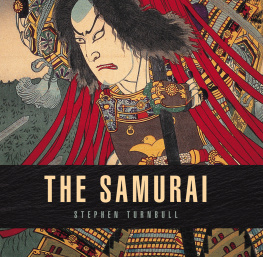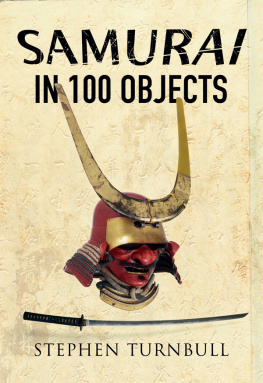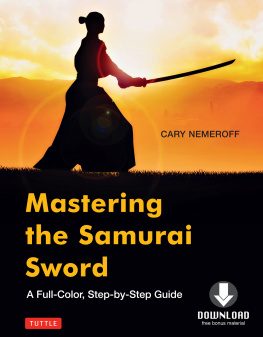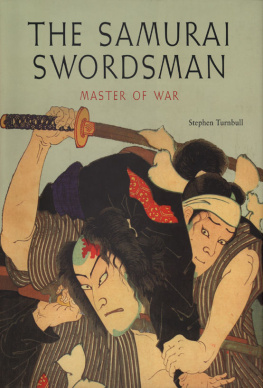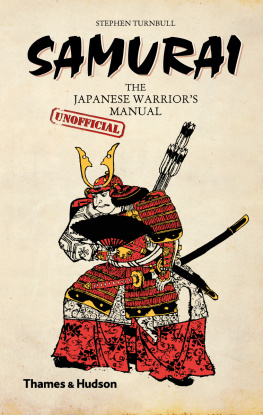Turnbull - The Samurai
Here you can read online Turnbull - The Samurai full text of the book (entire story) in english for free. Download pdf and epub, get meaning, cover and reviews about this ebook. year: 2016, publisher: Bloomsbury Publishing, genre: Religion. Description of the work, (preface) as well as reviews are available. Best literature library LitArk.com created for fans of good reading and offers a wide selection of genres:
Romance novel
Science fiction
Adventure
Detective
Science
History
Home and family
Prose
Art
Politics
Computer
Non-fiction
Religion
Business
Children
Humor
Choose a favorite category and find really read worthwhile books. Enjoy immersion in the world of imagination, feel the emotions of the characters or learn something new for yourself, make an fascinating discovery.
- Book:The Samurai
- Author:
- Publisher:Bloomsbury Publishing
- Genre:
- Year:2016
- Rating:4 / 5
- Favourites:Add to favourites
- Your mark:
- 80
- 1
- 2
- 3
- 4
- 5
The Samurai: summary, description and annotation
We offer to read an annotation, description, summary or preface (depends on what the author of the book "The Samurai" wrote himself). If you haven't found the necessary information about the book — write in the comments, we will try to find it.
The Samurai — read online for free the complete book (whole text) full work
Below is the text of the book, divided by pages. System saving the place of the last page read, allows you to conveniently read the book "The Samurai" online for free, without having to search again every time where you left off. Put a bookmark, and you can go to the page where you finished reading at any time.
Font size:
Interval:
Bookmark:

DEDICATION
This book is dedicated to Sue Brayshaw and John Head who got married on 2 April 2016, with best wishes.
IMAGE ACKNOWLEDGEMENTS
All images are from the Authors collection unless otherwise specified.
Cover: Menju Ietora, the standard-bearer of Shibata Katsuie, fights to defend his golden Shinto gohei standard from the enemy.
A NOTE ON DATES
For the convenience of readers the lunar dates used in the primary sources have been converted to the Western calendar.
A NOTE ON NAMES
Following conventional Japanese usage, all names are given with the surname first (e.g. Minamoto Yoritomo). Those mentioned in the text are referred to by their given name after the first mention (e.g. Minamoto Yoritomo, thereafter referred to as Yoritomo). In the final chapter, the surname is used.
JAPANESE WORDS
A glossary of the key Japanese words and phrases that appear in the text can be found at the end of this work. These words appear in italics at their first mention.
Osprey Publishing supports the Woodland Trust, the UKs leading woodland conservation charity. Between 2014 and 2018 our donations will be spent on their Centenary Woods project in the UK.

Minamoto Yoshiie leads his samurai into action during the so-called Later Three Years War. (Stephen Turnbull/ Japan Archive)

Samurai in mounted combat. Detail of painted screen scenes from the 12th century Gempei War, Tosa School, Edo Period, early 17th century. (Photo by DeAgostini/Getty Images)
First published in Great Britain in 2016 by Osprey Publishing, PO Box 883, Oxford, OX1 9PL, UK 1385 Broadway, 5th Floor, New York, NY 10018, USA E-mail:
This electronic edition published in 2016 by Bloomsbury Publishing Plc
Bloomsbury is a registered trademark of Bloomsbury Publishing Plc
2016 Osprey Publishing Ltd
This volume comprises text previously published in the following books by Stephen Turnbull: Samurai: The World of the Warrior; Warriors of Medieval Japan; The Samurai and the Sacred and Weapon 29 Katana: The Samurai Sword. With supplementary material from the following books by Anthony J. Bryant: Elite 23 The Samurai; Warrior 7 Samurai 15501600. Artwork by Angus McBride and Peter Dennis, previously published in Warrior 7 and Strongholds of the Samurai, respectively.
All rights reserved
You may not copy, distribute, transmit, reproduce or otherwise make available this publication (or any part of it) in any form, or by any means (including without limitation electronic, digital, optical, mechanical, photocopying, printing, recording or otherwise), without the prior written permission of the publisher. Any person who does any unauthorised act in relation to this publication may be liable to criminal prosecution and civil claims for damages.
Every attempt has been made by the Publisher to secure the appropriate permissions for material reproduced in this book. If there has been any oversight we will be happy to rectify the situation and written submission should be made to the Publisher.
A CIP catalogue record for this book is available from the British Library.
Stephen Turnbull has asserted his right under the Copyright, Designs and Patents Act, 1988, to be identified as the Author of this Work.
ISBN: 978-1-4728-1372-5 (HB)
ISBN: 978-1-4728-1374-9 (eBook)
ISBN: 978-1-4728-1373-2 (ePDF)
www.ospreypublishing.com
To find out more about our authors and books visit www.ospreypublishing.com. Here you will find our full range of publications, as well as exclusive online content, details of forthcoming events and the option to sign up for our newsletters. You can also sign up for Osprey membership, which entitles you to a discount on purchases made through the Osprey site and access to our extensive online image archive.
INTRODUCTION

In spite of all the emphasis in Heike Monogatari (The Tale of the Heike) on individual heroics and single combat, many of the battles of the Gempei War were won by setting fire to a building and then attacking the defenders as they ran out.
The samurai were the legendary warriors of old Japan who led noble and violent lives governed by the demands of honour, personal integrity and loyalty. They are defined in the modern imagination by the deadly swords that they carried and their famous code: bushido, the way of the warrior. But their martial prowess was just one facet of the lives of these iconic fighters. This book goes beyond the battlefield to explore all aspects of samurai life, throwing light on their home lives, religious and social background as well as cultural accomplishments. It provides a romp through samurai history, from the origins of the warrior class to its abolition in the 19th century. In other words, it presents a brief history of the samurai from swords to suits, from top-knots to top hats.
ANCESTORS OF THE SAMURAI
Ancient Japan was dominated by several rival clans, but by AD 400 one had emerged triumphant in the struggle. The name by which the victors are known to history is Yamato, and they are key figures because the Yamato rulers are the ancestors of the Japanese imperial line.
We know very little about the historical processes that took place to give power to the Yamato state, although many pointers have been gleaned from archaeology. Instead the origins of the imperial line are contained in some very colourful legends written down as a series of creation myths when the emperor system had become well established. They are preserved as the Kojiki (The Record of Ancient Events) of AD 712 and the Nihongi (The Chronicles of Japan) of AD 720. These legends of gods and heroes tell us nothing of wars between tribesmen or of one clan dominating the others. Such activities have to be inferred from tales of gods slaying serpents in distant lands. The best-known myth, and the one that is fundamental to understanding the cult of the emperor which retained its power through the ages even to the 20th century, tells how Amaterasu the sun goddess founded the Japanese imperial line when she sent her grandson down from heaven to rule the land of luxuriant rice fields.
Many challenges were made by rival uji (the ancient clans) against the dominance assumed by the Yamato rulers. All were ultimately unsuccessful and, by the 7th century, the imperial line felt sufficiently secure to introduce far-reaching legislative changes for Japan. The Taika reforms of 646 were an ambitious set of edicts that sought to curtail any remaining power possessed by the surviving clans by making all of Japan subject to the emperor. One of the first tasks of the reforms was to establish Japans first permanent capital city. This was achieved after a couple of false starts at Nara in 710. Buddhism, introduced to Japan two centuries earlier, flourished in the settled conditions of Nara. The government of Japan, like the design of the capital itself, was modelled on Tang China, and for some time the combination of the two provided a stable society.
Font size:
Interval:
Bookmark:
Similar books «The Samurai»
Look at similar books to The Samurai. We have selected literature similar in name and meaning in the hope of providing readers with more options to find new, interesting, not yet read works.
Discussion, reviews of the book The Samurai and just readers' own opinions. Leave your comments, write what you think about the work, its meaning or the main characters. Specify what exactly you liked and what you didn't like, and why you think so.

